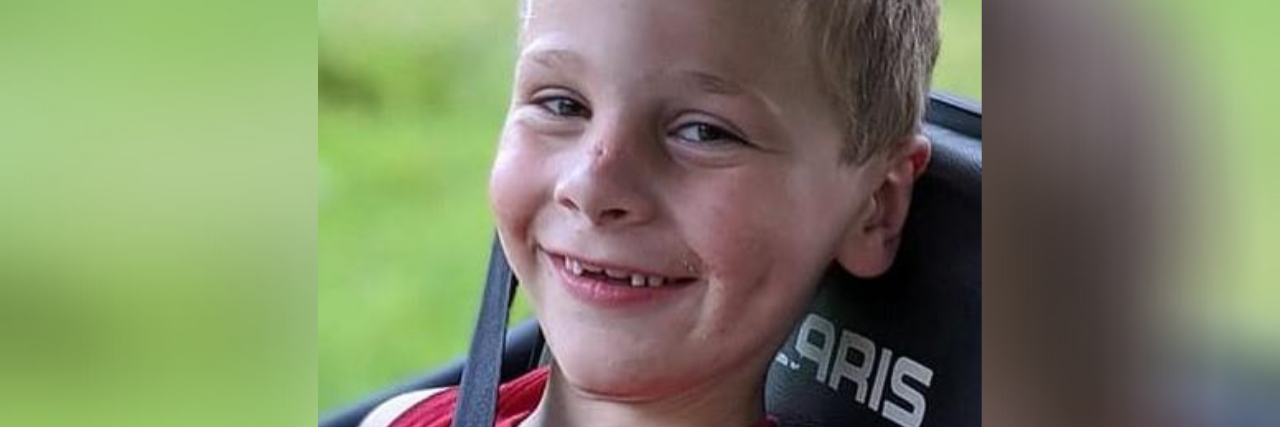If you strongly believe it’s your right to choose whether to wear a mask during the coronavirus pandemic, then you might not want to read this. On the other hand, it might a good idea if you could read it with an open mind to understand our perspective.
My son Teddy just turned 7, and he cannot wear a mask. He has significant developmental delays, and he simply does not comprehend that a mask needs to stay on his face. He removes a mask the same way he does every pair of sunglasses or hat that we place on his head. It might stay on for a period of time, anywhere from literally a second to 30 or more minutes depending on the hat and whether it has a string for him to chew. Teddy has extensive sensory needs that include the constant need to chew on something, so something covering his mouth is only going to end up in his mouth. And a potentially contaminated mask does not belong in his mouth. Nor does it belong on my head, which is also realistic because Teddy likes the game of placing his belongings he removes onto other people.
There’s more to know about Teddy. He took an ambulance ride to the emergency room due to strep throat and spent the night there. He had another ambulance ride and ICU stay for an ear infection and stomach bug. Any illness, particularly one that causes a fever, can trigger seizures. And once those seizures didn’t stop until he was so heavily medicated that he needed to be intubated. If strep throat sends him to the hospital, a reasonable person can understand why we’re extremely concerned about the risk COVID poses to him. We like to pretend we don’t have a medically fragile child, but the reality is that label fits him.
So where does that leave us? At home.
Pretty much, that’s the only safe place for Teddy to play, which means that’s the only safe place for his 8-year-old brother to play. We even have to come inside when our neighbors are playing outside. Teddy doesn’t understand who we cannot play with or near them. We’ve made a few trips to parks when no one else is there, with the plan to leave as soon as someone else arrives, hand sanitizer on hand for immediately afterward and 1:1 supervision to keep Teddy’s mouth off everything due to his sensory issues. We’ve done bike rides and runs, but only in places where there’s plenty of room to distance and/or limited people.
Teddy hasn’t been in a store in four months. Before the pandemic, he was routinely in stores at least once a week because we took him along to run errands because he loves people (and trips to stores greatly helped improve his moods when he was crabby). What would it take for Teddy to be able to go into the store again? Everyone who can wear a mask to wear a mask.
We understand that for masks to be fully effective, both people in a situation need to wear them. Only one person wearing a mask doesn’t offer full protection. But, the best we can hope for with Teddy is partial protection, and unfortunately, we have to settle for that because we can’t isolate him at home. He needs multiple therapies to help work on the skills we take for granted: communicating, dressing ourselves, walking and so much more. He needs to go to appointments for adaptive equipment like AFOs, braces that help him be so much steadier on his feet and prevent him from snapping his ankles with his extremely flexible joints and lack of coordination.
The issue of a mask comes to the forefront at these appointments. At his therapy appointments, his therapists all wear masks, most often the respirator masks, and sometimes eye protection. His physical therapist informed me recently that she fields a lot of questions from even her family members on why she wears a mask everywhere. She does it to protect “her kids.” She recognizes she works with a vulnerable population and takes those steps to ensure their safety.
Unfortunately, not even all service providers feel the same. When we went in June to get Teddy fitted for his braces, I was surprised and uncomfortable that no one was wearing masks. For the second appointment, my husband called to request the person who worked directly with Teddy wear a mask. He did, but he also shared his thoughts on the virus being similar to the flu and how masks “aren’t necessary.” We made the same request for the final fitting appointment and got yet another earful of opinions. This time it was questions about why Teddy wasn’t wearing a mask. We simply explained Teddy cannot wear one due to sensory issues, which this person should know because he’s worked with Teddy for six years. We shouldn’t have to explain or defend why we’re requesting a medical professional to wear a mask when interacting with our son.
Wearing a mask isn’t your personal decision, any more than the decision to drive intoxicated is your personal decision. Personal decisions are things that impact you: whether you get a tattoo, dye your hair lime green, eat ice cream for dinner or even wear your seatbelt. They impact you and your health, so they still impact others who care about you if you make negative choices that lead to becoming ill, injured or deceased. But they don’t inherently pose the risk to others and they don’t take away the ability of others to be in our community.
It’s been said by so many in different ways. Wearing a mask isn’t about you, although it certainly keeps you safer. Wearing a mask protects others, especially those like our son who have the double burden of medical fragility and the inability to physically wear a mask.
I’m not asking for sympathy for our situation. I’m asking for a bit of empathy, which means you’ll wear a mask in public. And it means I won’t have to make special requests for you to wear a mask to interact with my son and then get the fifth degree.


